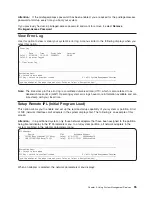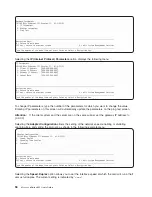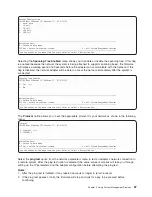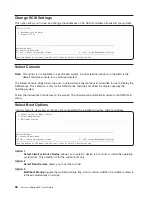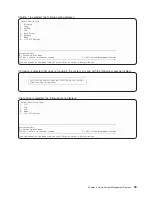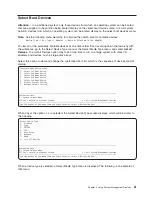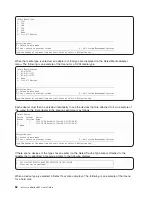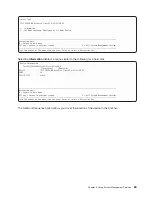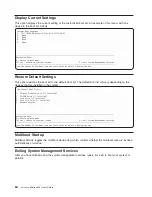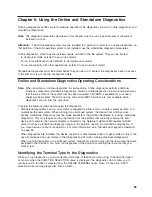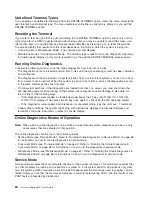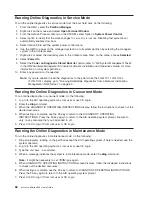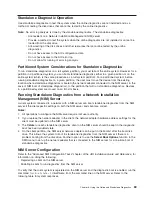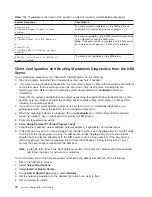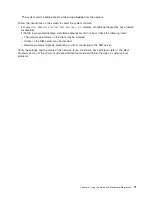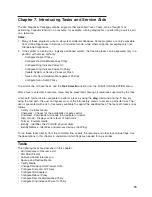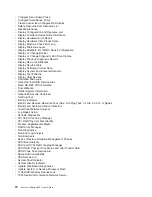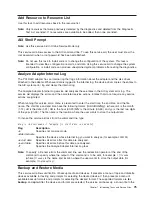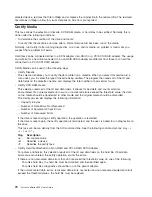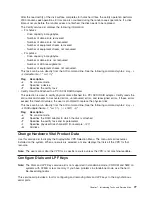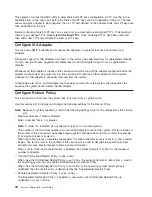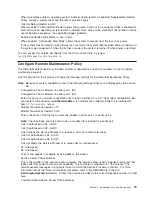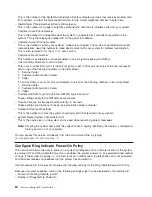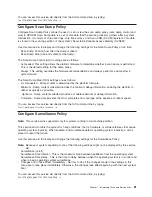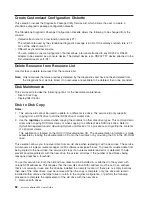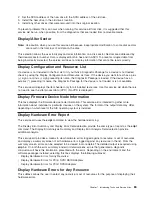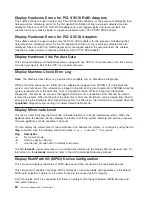
Standalone
Diagnostic
Operation
Use
standalone
diagnostics
to
test
the
system
when
the
online
diagnostics
are
not
installed
and
as
a
method
of
testing
the
disk
drives
that
cannot
be
tested
by
the
online
diagnostics.
Note:
No
error
log
analysis
is
done
by
the
standalone
diagnostics.
The
standalone
diagnostics:
v
Are
resident
on
a
Network
Installation
Management
(NIM)
server
v
Provide
a
method
to
test
the
system
when
the
online
diagnostics
are
not
installed
or
cannot
be
loaded
from
the
disk
drive
v
Allow
testing
of
the
disk
drives
and
other
resources
that
cannot
be
tested
by
the
online
diagnostics
v
Do
not
have
access
to
the
AIX
configuration
data
v
Do
not
have
access
to
the
AIX
error
log
v
Do
not
allow
for
running
of
error
log
analysis
Partitioned
System
Considerations
for
Standalone
Diagnostics
To
run
standalone
diagnostics
on
a
full
system
partition,
you
must
reboot
the
entire
system.
However,
for
a
partition
in
a
partitioned
system,
you
can
boot
standalone
diagnostics
either
in
a
given
partition
or
on
the
entire
system
(which
is
the
same
procedure
as
a
full
system
partition).
For
a
partitioned
system,
before
running
standalone
diagnostics
on
a
given
partition,
the
user
must
move
the
device
from
the
existing
location
where
standalone
diagnostics
is
booted
(the
network
adapter
connected
to
the
NIM
server,
in
the
case
of
NIM
boot
of
standalone
diagnostics),
to
the
partition
that
will
run
standalone
diagnostics.
Devices
in
a
partitioned
system
are
moved
on
an
I/O-slot
basis.
Running
Standalone
Diagnostics
from
a
Network
Installation
Management
(NIM)
Server
A
client
system
connected
to
a
network
with
a
NIM
server
can
boot
standalone
diagnostics
from
the
NIM
server
if
the
client-specific
settings
on
both
the
NIM
server
and
client
are
correct.
Notes:
1.
All
operations
to
configure
the
NIM
server
require
root
user
authority.
2.
If
you
replace
the
network
adapter
in
the
client,
the
network
adapter
hardware
address
settings
for
the
client
must
be
updated
on
the
NIM
server.
3.
The
Cstate
for
each
standalone
diagnostics
client
on
the
NIM
server
should
be
kept
in
the
diagnostic
boot
has
been
enabled
state.
4.
On
the
client
partition,
the
NIM
server
network
adapter
can
be
put
in
the
bootlist
after
the
boot
disk
drive.
This
allows
the
system
to
boot
in
standalone
diagnostics
from
the
NIM
server
if
there
is
a
problem
booting
from
the
disk
drive.
Another
option
is
to
use
the
Select
Boot
Options
function
in
the
SMS
menu
to
set
up
the
network
adapter
that
is
connected
to
the
NIM
server
for
a
one-time
boot
of
standalone
diagnostics.
NIM
Server
Configuration
Refer
to
the
“Advanced
NIM
Configuration
Tasks”
chapter
of
the
AIX
Installation
Guide
and
Reference
,
for
information
on
doing
the
following:
v
Registering
a
client
on
the
NIM
server
v
Enabling
a
client
to
run
diagnostics
from
the
NIM
server
To
verify
that
the
client
system
is
registered
on
the
NIM
server
and
the
diagnostic
boot
is
enabled,
run
the
command
lsnim
-a
Cstate
-Z
ClientName
from
the
command
line
on
the
NIM
server.
Refer
to
the
following
table
for
system
responses.
Chapter
6.
Using
the
Online
and
Standalone
Diagnostics
69
Summary of Contents for p 655 series
Page 1: ...pSeries 655 User s Guide SA38 0617 03 ERserver...
Page 2: ......
Page 3: ...pSeries 655 User s Guide SA38 0617 03 ERserver...
Page 10: ...viii Eserver pSeries 655 User s Guide...
Page 14: ...xii Eserver pSeries 655 User s Guide...
Page 16: ...xiv Eserver pSeries 655 User s Guide...
Page 24: ...6 Eserver pSeries 655 User s Guide...
Page 32: ...14 Eserver pSeries 655 User s Guide...
Page 36: ...18 Eserver pSeries 655 User s Guide...
Page 90: ...72 Eserver pSeries 655 User s Guide...
Page 144: ...126 Eserver pSeries 655 User s Guide...
Page 208: ...190 Eserver pSeries 655 User s Guide...
Page 214: ...196 Eserver pSeries 655 User s Guide...
Page 217: ......

